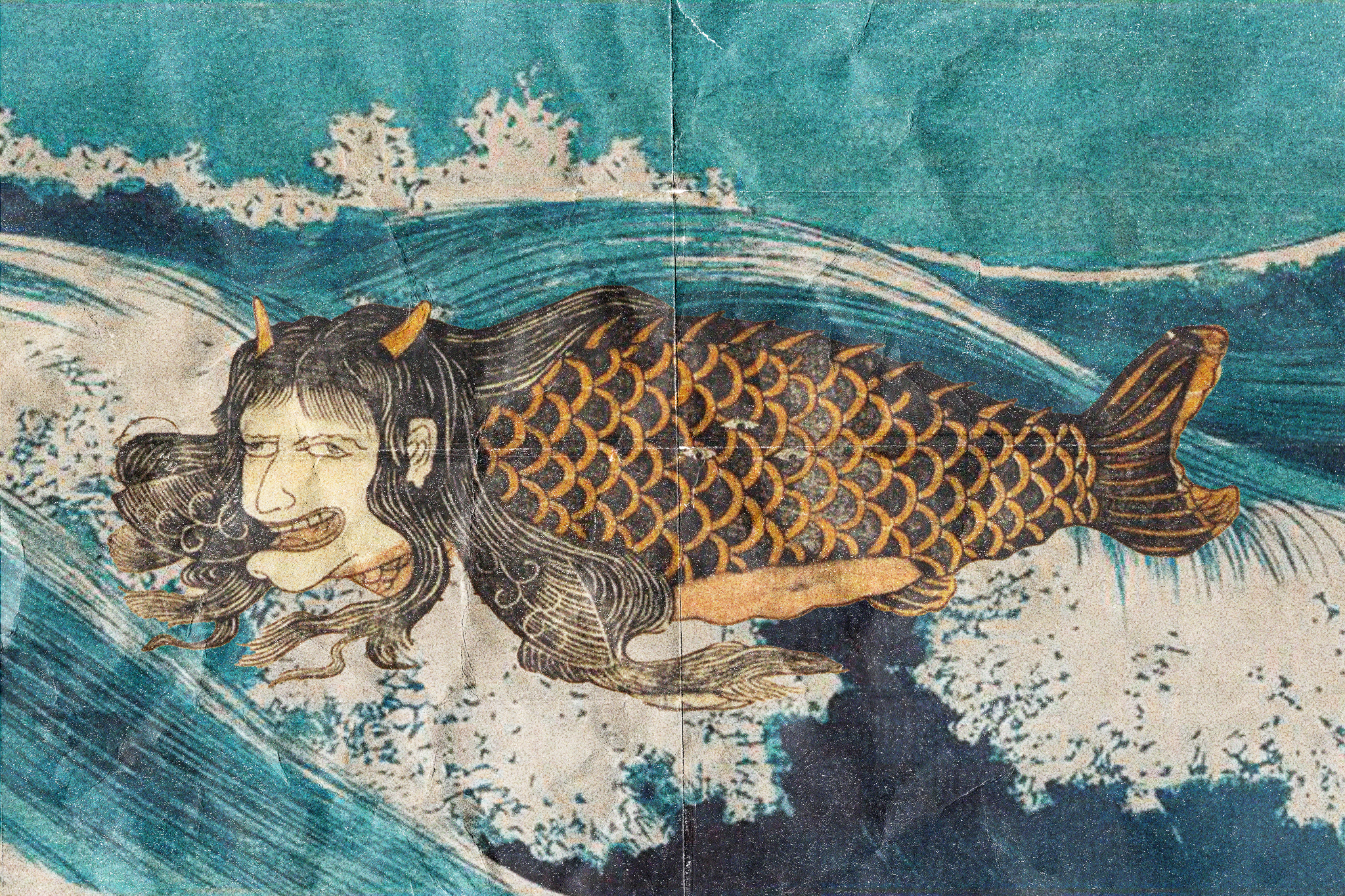Western pop culture exerts a powerful influence on Japan. Nowadays, when Japanese people hear the word ningyo (“human fish”), which is their term for “mermaid,” they think of the variety popularized by Disney and Hans Christian Andersen: a beautiful woman with a fish’s body from the waist down, despite “ningyo” originally meaning something very different. Then again, it probably wasn’t that much of a struggle to put the old image of the Japanese mermaid to rest, seeing as it involved high-octane nightmare fuel with just a touch of semi-cannibalism.
What a Traditional Japanese Mermaid Looks Like
Japanese mermaids have been described very differently, depending on the time and place. Early accounts from northern Japan in the 13th century talk of fishermen catching strange fish shaped “like a human corpse.” The Kokon Chomonju, a collection of myths and legends completed in 1254, contains a passage about people in Ise Province (modern-day Mie Prefecture) coming across fish with human heads, monkey-like faces and protruding mouths. They reportedly cried when anyone tried to approach them, though why anyone would want to do that is unclear. This image of large fish with human heads then had a few offshoots. In some descriptions, the ningyo don’t cry but rather talk with the voice of a child or trill like a skylark. Because it’s nice to have options on one’s descent into madness.
Later accounts talk of strange sea creatures washing up on Japanese shores with four limbs like a human but with bonus fish tails and scales. In the 1331 Hojo Kudai-ki chronicle, there is even talk of what can be best described as “reverse mermaids”: humanoid creatures with fish heads. Not all of these cryptids were called “ningyo” at the time, but were retroactively classified as proto-mermaids in the early 18th century when human fish in Japanese artwork started somewhat resembling Ariel. This was perhaps due to the influence of foreign sailors who helped spread the European image of mermaids before Japan entered its long isolationist period in the mid-17th century. And speaking of Ariel.
The (Potential) Origins of Ningyo in Japan
When describing ningyo in the 17th century, famed Japanese poet and artist Ihara Saikaku recalled a story of a mysterious fish with the face of a beautiful woman and, interestingly, a red chicken’s comb. A few other accounts of ningyo mention similar extra appendages or mermaids with red hair, leading some researchers to trace the origin of the myth to the oarfish.
A massive, elongated sea creature that can grow up to 17 meters in length, the oarfish is characterized by a long, red-colored dorsal fin, and is actually quite a proficient myth-maker, as it’s also believed to be the source of stories of giant sea serpents. So, when Disney’s The Little Mermaid premiered in Japan and starred a ginger “human fish,” maybe that helped bridge the gap between the image of Japanese and western mermaids in the Japanese psyche? Probably not, but it’s fun to think about it that way.
Another possible source of ningyo are Japanese giant salamanders, which do sort of look like half-human, half-fish creatures from far away on foggy mornings after a night of heavy drinking. Also, Japanese salamanders do live quite a long time, possibly explaining why, in so many ningyo myths, people are eating them.
Side Note: Apparently Japanese Mermaids Taste Delicious
A thing we left out from the previously-mentioned Kokon Chomonju account is that the people who caught the screaming monkey-fish mermaids immediately killed and ate them. Why? They apparently tasted “delicious.” This story is possibly tied to the myth of Yaobikuni, a legendary nun who supposedly lived for 800 years while retaining her youthful appearance after accidentally eating ningyo meat (of the “fish with a human head” variety.) In Japanese mythology, mermaid flesh is said to grant eternal life, but Yaobikuni got out of that curse by praying hard in what is today Fukui Prefecture until she turned to stone.
Some scholars from the Edo Period (1603–1868) believed there was a lot of truth to this legend and consumed powdered “ningyo bones,” or whatever it was they were scammed into buying, in order to extend their lives. And you thought taking rhino horn for erectile dysfunction was weird.
There are other reasons to avoid mermaids other than accidentally achieving immortality. Besides being good eats, legend goes that ningyo are also bad omens, predicting disaster. Early on, their reported sightings did often coincide with people losing their lives, like the story of the “human corpse” mermaid, which supposedly preceded the defeat of the Miura clan by the Hojo. Similar “coincidences” popped up all through early Japanese history, which might be some kind of literary device that we still don’t fully understand, or is the result of a totally-understandable curse brought on by humans eating magical creatures. Both explanations are equally probable.









